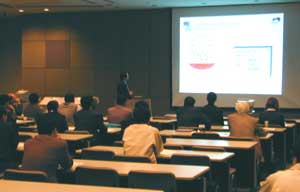|
|
|
|
|
|
Corrosion Symposium Report
 A
corrosion symposium titled gSymposium on Recent Trends in Corrosion
Researchh was held on Tuesday, November 25 in Conference Room 1 of NIMS.
A
corrosion symposium titled gSymposium on Recent Trends in Corrosion
Researchh was held on Tuesday, November 25 in Conference Room 1 of NIMS.
New techniques are being called for to clarify the mechanisms of corrosion because the environment where metallic materials are being used is becoming more diversified, and it is becoming necessary to control the degradation that occurs by corrosion in each environment. The importance of corrosion research is starting to receive more attention while there is a continual increase in the amount of metallic materials being used in this world, especially in the economically developing Asian countries. In the midst of these situations, this symposium was held with the purpose of discovering the current trends of corrosion research that is being conducted in Europe, Asia, and Japan.
Although we did not receive much good weather that day, a total of approximately 70 members from 5 countries including Japan, Germany, China, India, and the Philippines showed up at the symposium.
We invited corrosion researchers representing various countries to present lectures at this symposium including Prof. Stratmann from the Max-Planck-Insitut fuer Eisenforschung in Germany, Prof. En-Hou Han from the Institute of Metal Research, Chinese Academy of Science in China, and Prof. V. Murugesan from Anna University in India, as well as Prof. T. Tsuru from the Tokyo Institute of Technology and Prof. S. Fujimoto from Osaka University. Dr. Y. Katada, Dr. H. Masuda, Dr. H. Kutsumi, and Dr. T. Shinohara also gave lectures explaining the research activities at NIMS. In total, nine lectures were held at this symposium.
The contents of the lectures covered a vast amount of material shown below, and active discussions were held on these subjects.
-
The concept of analysis of delamination of polymer coatings on Zn plated steels by means of Kelvin probe
-
The influence of rust layer on hydrogen entry into steel
-
Role of additive elements on semiconductive property of passive films on Fe-Cr alloys
-
Analyses of passive films formed on stainless steels by means of XPS
-
Influence of acid rain on atmospheric corrosion of high strength aluminum alloys
-
Development and application of high nitrogen stainless steels
-
Observation of corrosion progress under simulated near seashore environment by using Kelvin force microscope
-
Improvement of steam oxidation resistance for ferritic heat resistant steels
-
Evaluation of atmospheric corrosion by means of ACM sensor and a noble technique for potentiodynamic polarization measurements under atmospheric corrosion condition
We hope that this symposium provided a chance to gain an insight into some of the corrosion research activities from various countries and served as a place to interact with other researchers.
In addition, this symposium was held with the support of CBMM Asia Co., Ltd., and we would like to express our deepest gratitude to them. We would also like to thank all the lecturers and everyone who gave us their support to make this symposium a success.
Dr. Eiji Akiyma, Physical Metallurgy Group